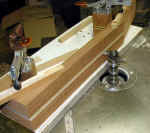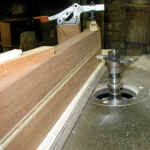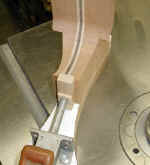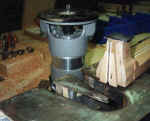MAKING THE NECKS -- 2
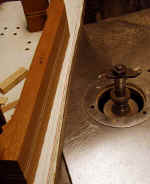 After the neck blank is sawn from the raw block, and
while it is still square, I cut the truss rod groove. I do this
on a spindle shaper. The jig has the curvature of the slot cut on
its front edge, and the the neck is firmly clamped in place. The
cutter (which I had made many years ago) is simply a round bottom 1/4"
cutter. There is a ball bearing that follows the edge of the jig
and makes the cutter cut a slot with the proper curvature. My truss
rod is a traditional Gibson style - anchored at the dovetail and adjusted
at the peghead. I find that if the slot is curved (i.e. slightly
deeper in the middle than at either end) it works better.
After the neck blank is sawn from the raw block, and
while it is still square, I cut the truss rod groove. I do this
on a spindle shaper. The jig has the curvature of the slot cut on
its front edge, and the the neck is firmly clamped in place. The
cutter (which I had made many years ago) is simply a round bottom 1/4"
cutter. There is a ball bearing that follows the edge of the jig
and makes the cutter cut a slot with the proper curvature. My truss
rod is a traditional Gibson style - anchored at the dovetail and adjusted
at the peghead. I find that if the slot is curved (i.e. slightly
deeper in the middle than at either end) it works better.
 And another - perhaps the curve in the jig is more visible here.
And another - perhaps the curve in the jig is more visible here.
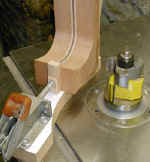 Here I am rough shaping the heel on the spindle shaper.
The jig is shaped like the heel, the cutter is straight and the ball bearing
rub collar rides on the edge of the jig, thereby cutting the heel.
Here I am rough shaping the heel on the spindle shaper.
The jig is shaped like the heel, the cutter is straight and the ball bearing
rub collar rides on the edge of the jig, thereby cutting the heel.
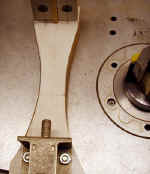 Another view of the heel shaping jig. Note the piece of maple in the
upright surface, which engages the truss rod slot and aligns the neck in
the jig.
Another view of the heel shaping jig. Note the piece of maple in the
upright surface, which engages the truss rod slot and aligns the neck in
the jig.
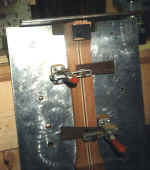 This is the jig which cuts the dovetail in the
neck. The photos should be fairly self-explanatory. The only
thing not visible is that there is a 1/4" wide piece on the face
of the jig which engages the truss rod slot and thereby ensures that the
neck is held in perfect alignment.
This is the jig which cuts the dovetail in the
neck. The photos should be fairly self-explanatory. The only
thing not visible is that there is a 1/4" wide piece on the face
of the jig which engages the truss rod slot and thereby ensures that the
neck is held in perfect alignment.
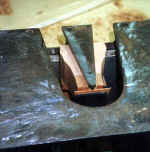 Here is the "working" part of the jig.
Here is the "working" part of the jig.
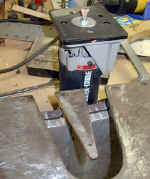 Another
view, with the router that cuts the joint.
Another
view, with the router that cuts the joint.
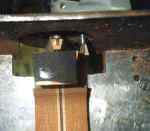 Here is the router and its cutter. The photo is
a bit dark but the router has a guide which follows the shape of the jig.
Here is the router and its cutter. The photo is
a bit dark but the router has a guide which follows the shape of the jig.
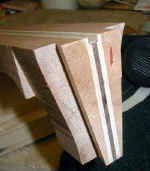 A
dovetail on a short heel - in this case for a parlor guitar.
A
dovetail on a short heel - in this case for a parlor guitar.
This website and all of its content, text and images are copyright ©1997-2011 by Charles A. Hoffman. All rights reserved.
